To most fly anglers, Norway is synonymous with big, powerful rivers and equally big salmon. However, few visitors realize that we also have a wealth of sea trout fishing. These are brown trout with the lifestyle and habits of the salmon—our two most celebrated gamefish rolled into one—combining the best of both species, and all the capriciousness of both.
Although fly fishing for sea trout in salt water has been practiced for well over half a century here in Northern Europe, it’s only in the past 25 years that it has actually become popular. For myself and many other Scandinavian fly anglers, it has opened up two entirely new seasons in the fishing calendar—winter and spring—when other fishing just isn’t available, because of our severe winters.
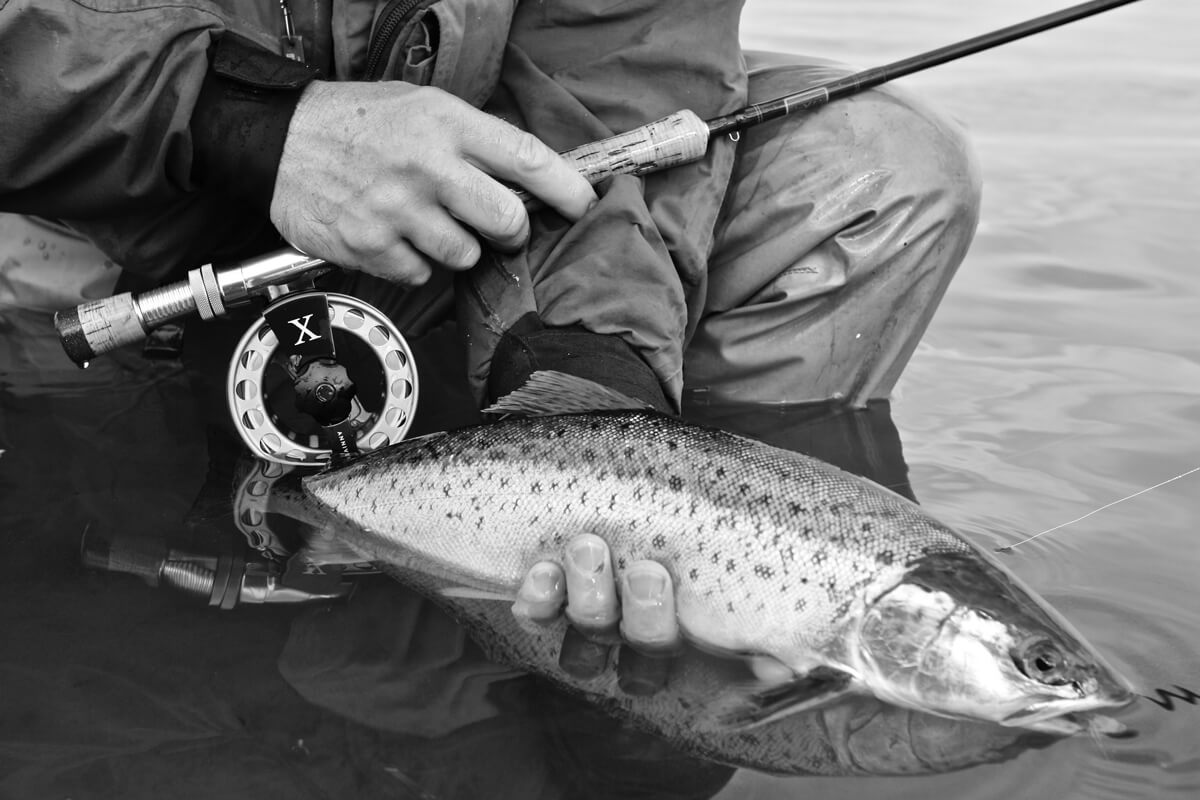 Norway is situated in the heart of Scandinavia. Northwest from Denmark and west from Sweden, Norway runs from the 58th parallel in the south to the 71st parallel north of the Arctic Circle. Norway has a coastline that is 21,347 kilometers (13,281 miles) long, including bays and fjords. In proportion to the country’s area, this coastline is longer than that of any other major country in the world. The Norwegian coastline faces the North Sea in the south, the Norwegian Sea (Atlantic Ocean) in the west and the Barents Sea in the north.
Norway is situated in the heart of Scandinavia. Northwest from Denmark and west from Sweden, Norway runs from the 58th parallel in the south to the 71st parallel north of the Arctic Circle. Norway has a coastline that is 21,347 kilometers (13,281 miles) long, including bays and fjords. In proportion to the country’s area, this coastline is longer than that of any other major country in the world. The Norwegian coastline faces the North Sea in the south, the Norwegian Sea (Atlantic Ocean) in the west and the Barents Sea in the north.
Springtime in Northern Europe starts slowly. On my latitude, the first hint of green can’t be seen before early to mid-April. It starts to show itself in last year’s dark and twiggy growth. The stark black lines of tree branches begin to soften as the longer days signal the change of season and the beginning of the awakening from winter.
When the spring sun has begun to warm the cold salt water of winter, it’s not only you who begins to feel the effects. Coastal sea trout, which have spent much of the winter in energy-saving mode, are now ready for the spring feast. For the coldest part of winter sea trout are as inactive as possible and hold to areas that are warmest and where the sea has a higher content of fresh water. They can be difficult to catch then, but a large streamer fished slowly can tempt a winter fish.
In late winter and early spring, look for areas containing warmer water, 4 degrees Celsius (39 degrees Fahrenheit) or more (a thermometer is an important piece of equipment for the serious sea trout angler). Concentrate on shallower, south-facing, sun-rich bays and beaches whose waters have some flow. It doesn’t take much more than this for the sea trout’s appetite to awaken from its winter’s sleep. Also look for structure in the water—large stones, islands, or cliffs. These structures collect and store heat from the sun, and this will warm the surrounding waters.
When water temperatures begin to rise over 5 degrees Celsius (41 degrees Fahrenheit), sea trout will become much more active in their hunt for food. They’re aggressive predators, and during spring and summer they need to fatten themselves up after the winter’s fast.
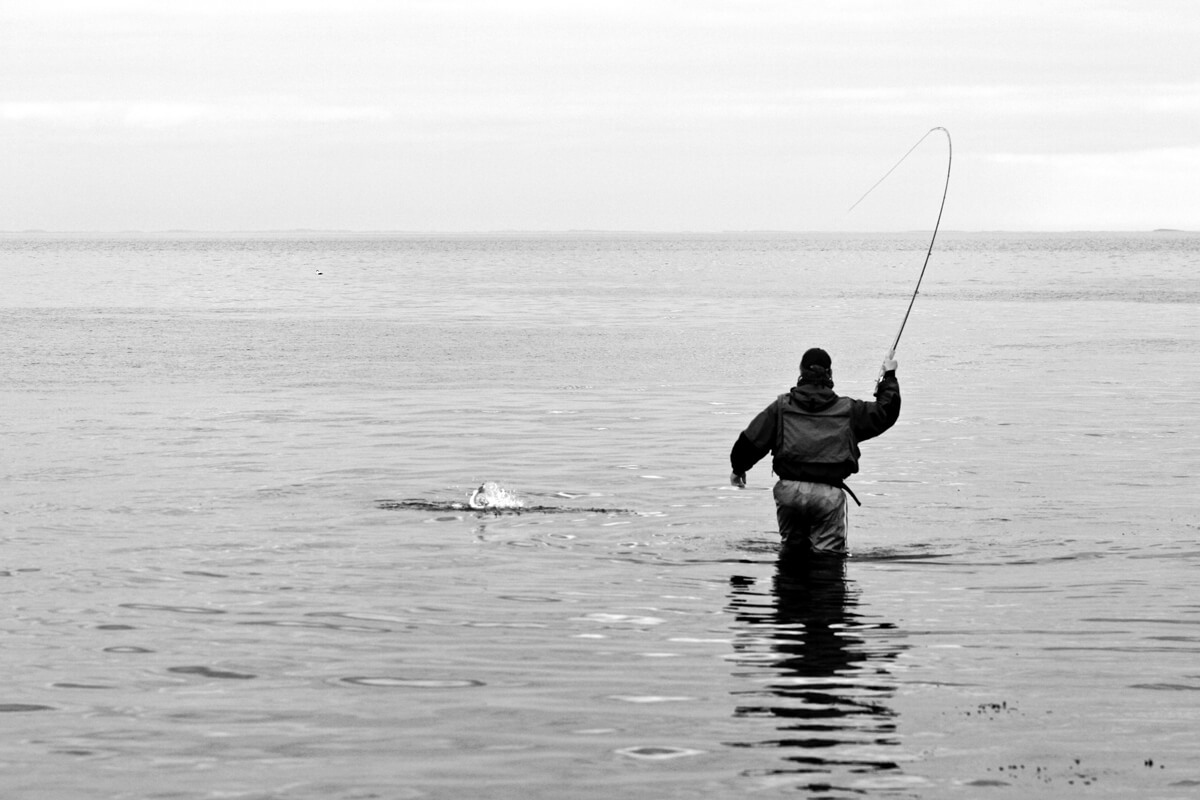
Fly fishing for coastal sea trout in Scandinavia always involves wading. Shore environments have a wide variety of wading conditions. From the archipelago of southern Norway traveling north along the coast, you’ll find boulders to pebbles and shingle and plain sand—all shorelines can produce fish. In winter and spring the sea can be extremely cold, so many anglers prefer warmer neoprene waders over thinner, breathable GORE-TEX.
Choose an outfit in the 6- to 8-weight range, depending on the wind, matched with a weight-forward floating or intermediate line. For flies, streamers, shrimp, and scud patterns are the norm in sizes 6 to 12. Choose your tippet based on the size of the hook, but sea trout generally are not leader-shy.
Look for patchy bottom of mixed sand and weeds, any sheltered spots in small bays, or deep runs between islands where the tide rushes through like a river. Keep in mind that sea trout are easily spooked. Start fishing before you come down to the water’s edge, and under no circumstances should you begin to wade before you’ve fished the shallows close to shore. A rule of thumb is to use a slow retrieve in winter and throughout spring. Fish your cast to the end—sea trout like to follow the bait a few meters before they take.
A good rule of thumb when fishing blind is to start by making a couple of casts, followed by a couple of steps, working your way along the shore, and repeat this until you contact fish. Sea trout are constantly on the move, foraging, and if you find one, there are generally more. If you don’t see or contact any fish within 15 minutes, move on to a new spot. It’s said that the most important piece of equipment for fishing saltwater sea trout is a car!
It’s also very common to see sea trout rising, just like trout cruising in a lake. If you can put a fly into the path of one of these rising fish, nine times out of ten they’ll pick it up!
Don’t look out the window and decide to stay home because it’s windy or raining. When the wind blows from the sea against the land, all the food in the top few meters of water will collect near the shore. And wherever there is the most food, that’s where the sea trout will be. An onshore wind produces some of the best fishing. Under the cover of bad weather and high waves, large, shy fish will come into the shallows to feed.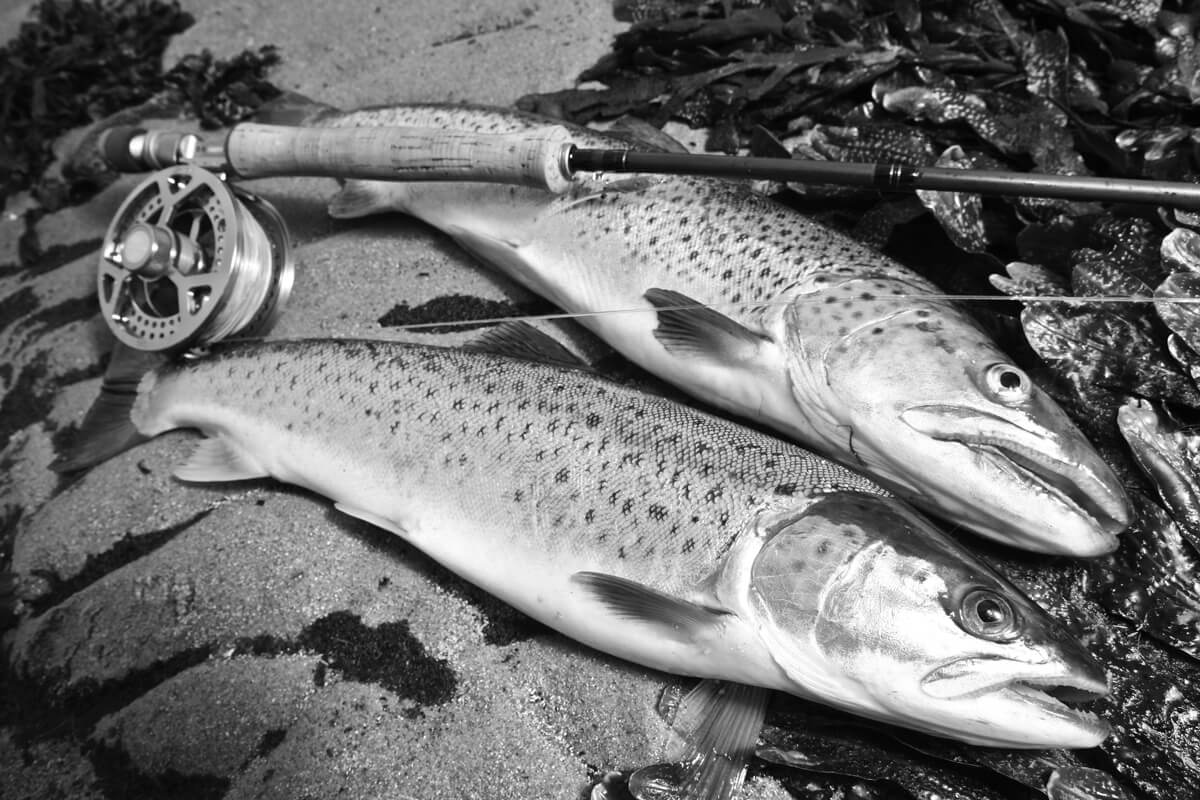
Another useful piece of equipment when wading the salt is a line tray or shooting basket. If you’re fishing an intermediate or sinking line, shooting line from the tray is much easier than trying to shoot line that’s sunk in the water. When fishing from shore, the tray helps keeping sand off the line and out of the iron grips of bladder weed.
In a river, trout are stationary much of the time and wait for their food to be brought to them. Rather like they’re in a restaurant, they eat what they’re served at the table. Sea-run trout, on the other hand, have to forage, and for the most part they feed “a la carte.” Sea trout in salt water feed on a wide variety of prey species, but at certain times of the year they can be quite selective, and you may have to “match the hatch.” For example, in early spring the ragworms swarm and spawn, creating the saltwater equivalent of a mayfly hatch. The ragworm’s wedding, as it is known, is considered the spring’s most exciting adventure for the sea trout angler. And if you’re lucky enough to be in the right place at the right time, you’re sure to connect with fish.
You can find ragworms in the stomach contents of sea trout the entire year, but in the spring when you’re fishing a large swarming, you’ll find that they’ll fall out of the mouths of fish when you land them. A ragworm fly should be fished slowly, so that it swims like it’s flowing in the water. If you experience that fish follow and will not take, it sometimes works if you place your rod under one arm and retrieve the fly a hand-over-hand.
Your chances of experiencing a large swarming are best after the water has risen in temperature above 6 or 7 degrees Celsius (43 to 47 degrees Fahrenheit) and around the full moon—but this is not a fast rule, as this year we experienced a swarming during a warmer day on a full moon in early March. Ragworm swarmings can be very local in most situations, and it’s not easy to know where they’ll happen.
In summer, too, sea trout will feed selectively on sand eels [see issue 47 May/June 2020 for Barry’s tying feature on the Flat-Wing Sand Eel, eds.]. Also, if you’re lucky and your timing’s right, great dry fly sport may also be had when flying ants hatch and blow off the forested coastline, triggering the silvery saltwater trout to rise as freely as their freshwater cousins.
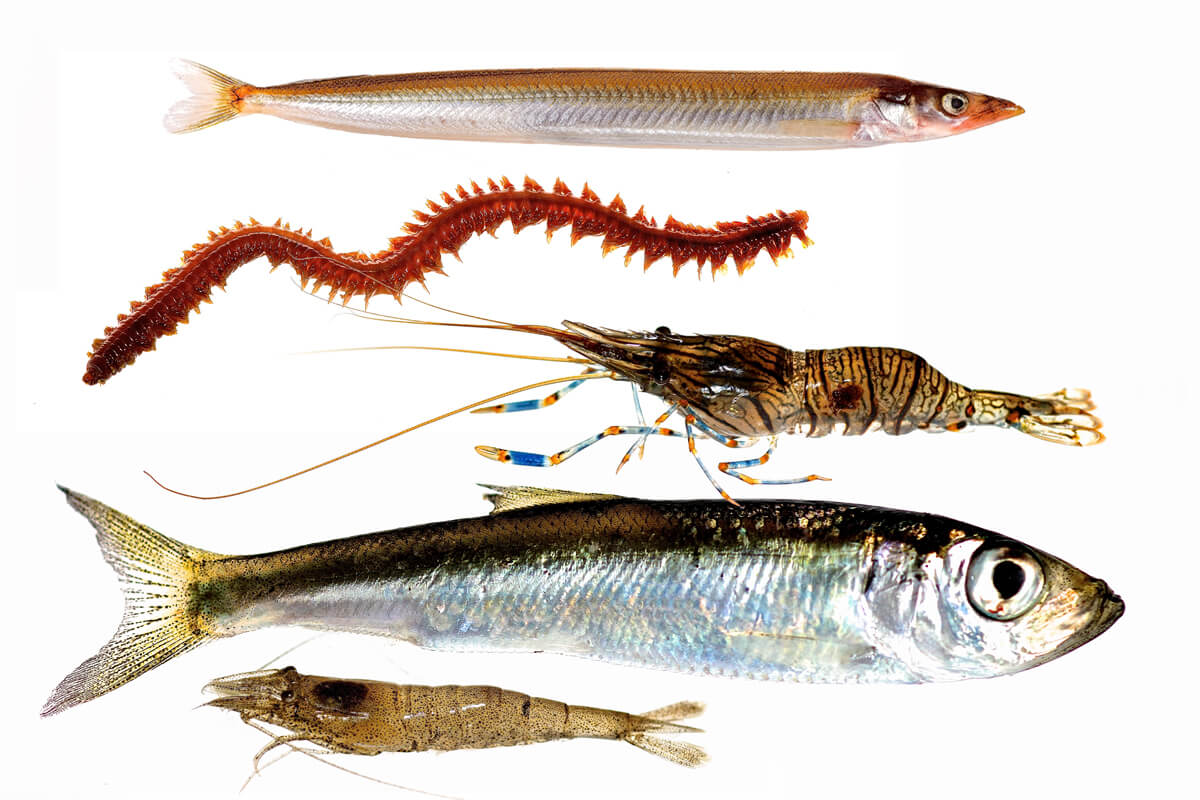
Late summer and autumn sees the arrival of the herring; this means big baitfish patterns. Herring shoal in the shallows, and under cover of darkness the larger trout cruise the shallows to feast on them. A sea trout can actually swallow and digest a fish that’s a third its own body weight, which is perhaps something to consider when designing and tying flies for them.
In general, night is a good time to fish for sea trout. Consider that the sun has been high in the sky all day and warming up the shallows, especially those with dark, muddy bottoms. These shallow areas retain the day’s heat during the first couple of hours of darkness. It’s during this period that larger sea trout venture into the shallows to feed—much shallower than many anglers would believe. You should fish at least a couple of hours into the night. Try using Muddler Minnows, which will push a bit of water when retrieved. Fish slowly and listen for splashes.
Night or pre-dawn fishing for sea trout holds a very special place in my fishing repertoire; however, because my night vision isn’t what it used to be, I now seem to spend more time changing flies and leaders than actually fishing.
There are many opinions about the best tides to fish for sea trout. In winter it’s most rewarding to fish the warmest part of the day, between 11:00 and 14:00 (2:00 p.m.), regardless of tide. When the water warms, in most cases it’s best to fish a couple of hours before the high tide to a couple of hours after.
There are also many many differing thoughts about the best times to fish. If I’m restricted by the amount of time I can fish, I have a simple rule: two hours before high tide or two hours before and into dark (if you can get both high tide and darkness to coincide, you’re generally onto a winner). However, the soundest advice anyone can give you is to fish when you have the chance. Those who fish the most will catch more fish and gain the most experience.
Last but not least: Unlike fishing for Atlantic salmon, fishing in salt water for sea-run browns in Norway is free; no national or local licenses are required, although fishing regulations vary from county to county.
Text and Photos by Barry Ord Clarke
Bio: Barry Ord Clark is an angler, fly tier, and photographer of international renown. He is the author of several books on fly fishing, the most recent of which is The Feather Bender’s Flytying Techniques (Skyhorse Publishing, 2019). Barry grew up in England but now lives in Norway. Be sure to visit his fly tying website (thefeatherbender.com).
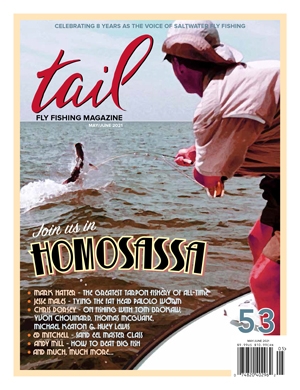 SUBSCRIBE TO TAIL FLY FISHING MAGAZINE
SUBSCRIBE TO TAIL FLY FISHING MAGAZINE
Fly Fishing the Lowcountry – Part Three: Migratory Species of the Lowcountry


One Comment